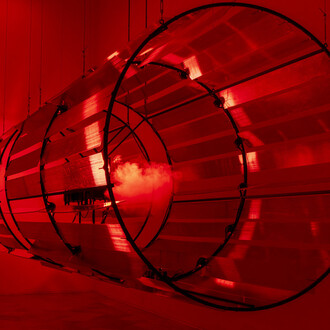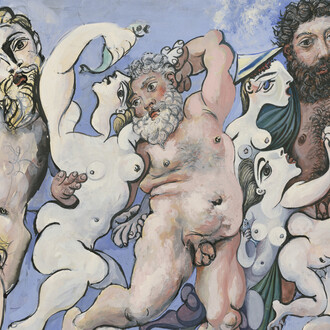Resurrecting only the skin, without the body that covers and belongs to it. Cristina Spinelli (Madrid, 1993) brings back to life the trimming of the drawing she made two years ago, with fire, on plasterboard walls, later repainted. The flourish burned into the wall was buried under the plastic paint; and now, the surfaces have been polished, the membranes have been torn from the plasterboard body and under the title of folus (aura) appear again like burnt clothes spread out on the floor. Like niches, like archaeological research plots. Archeology as scar.
Spinelli does not give up thinking about her artistic practice in terms of language. Plasterboard is important because it is a conjugation of different materials -paper, plaster, aluminum, fiberglass-. Intervening it, disintegrating it and recovering a language that had been hidden within means undoing a palimpsest and revealing a text that develops in an elliptical, umbelliferous way.
These skins stretched on the floor interpellate, morphologically, the layers of rice paper of umbela [umbel], the exhibition’s homonymous work that grows like a flower on the wall of the showroom joining fragments of clothing patterns. Again, a surface that emphasizes the absence of the body it clothes. We find it also in ◠◠ and ◡◡ , the ceramic works made from the mold of the artist’s legs. In some we find wax that is sheltered in its concave part; in others, what is sheltered in the concavity are some wildflowers that Spinelli raided and preserved inside a book.
Because hiding and burying are forms of protection. A protection without guarantees. Like the nervous and erratic language that has freed itself from the compact homogeneity of plasterboard, Umbel·la [Umbel] as an exhibition shows us a nature that can no longer show itself or act as a block, with a certain consistency. It is in this sense that, sin título [untitled], it is shown to us spineless and worn out, and the binding that characterizes this object takes on a new grammar, emerging from the pages that hide it -like the flowers now in the ceramic pieces- to take on visibility.
A final characteristic of Umbel·la is viscerality, a certain melodramatic sense. Going all in, with everything, brutally. They are proposals made point-blank. Collapsing to rise again, like tus geranios con nosotras [your geraniums with us], a 2021 sculpture that now opens to show its insides. But the most ethereal works also show a certain fatigue or an emotional impact about to explode, like encender un fuego [light a fire], the sound work that fills the room with the sound of castanets; or last, the projection that is there and is not there, waiting for someone to give it support to manifest itself. And also Daniel, the spoon suspended in the air. One last umbel, umbrella, about to fall. About to lose.
In Umbel·la nothing ends in a painful result, but it does end at the limit of outburst.
(Text by Jordi Vernis. Umbel·la is a solo exhibition created by Cristina Spinelli and curated by Jordis Vernis)
Cristina Spinelli (Madrid, 1993). Her work explores the idea of disappearance and the desire to keep through artefacts, archives and folklore, focusing on processes of disarticulation and reconstitution of materials and pieces. She has received awards and grants such as: Ezprogui Residency, in collaboration with Centro de Arte Contemporáneo de Huarte, Pamplona; XXXII Circuitos de Artes Plásticas de la Comunidad de Madrid; Residencies of artistic production, Matadero, Madrid; Can Felipa Arts Visuals, Barcelona; Ayudas Injuve para la Creación Joven; Residency at ETOPIA Centro de Arte y Tecnología, Zaragoza. Among her solo exhibitions are: umbel-la, Centre de Lectura de Reus (2024); Que me entierren con todo, NoguerasBlanchard, Barcelona (2022); Escribir como un jardín, Can Felipa Arts Visuals, Barcelona (2021); 47o22.00.0 "N 8o33.00.0” E, ETOPIA Centro de Arte y Tecnología, Zaragoza (2017); Memory is a software, Despliegue, Madrid, collaborating with Álvaro Chior (2016). Among her group exhibitions are: Self super and hart:and kind for eribodi, Galerie Krinzinger, Vienna (curated by Secundino Hernández); El nivell perceptiu més immediat, Konvent Puntzero, Berga, Barcelona (2023); Swim safe, Gresite, Madrid (with Alfredo Rodríguez); Romantic bullets position effectively, Vilaseco Gallery, A Coruña (curated by Sonia Fernández Pan) (2022); Dialecto CA2M, Centro de Arte 2 de Mayo, Madrid (curated by Manuel Segade and Tania Pardo); Super superlike, Condeduque, Madrid (curated by Marta Ramos-Yzquierdo and Enrique Radigales); Circuitos de Artes Plásticas, Sala de Arte Joven, Madrid (curated by Joaquín Jesús Sánchez) (2021); Un gesto que permanece, Salón, Madrid (curated by Vera Martín Zelich); Exposición Artes Visuales Injuve, Sala Amadís, Madrid (2019). Her work is part of the Contemporary Art Collection of the Community of Madrid, held at the CA2M.
Jordi Vernis López (Barcelona, 1985). Curator, critic and researcher whose projects focus on the performative and on influencing the conflicts between the public and the private, whether in their visual dimension or in those that allow research into subjects such as orality, improvisation and language. With a degree in Art History and Phi losophy, he studies mediation and criticism (ADesk, On Mediation, NODE). He carries out collective projects such as *Yo, misil (co-curated at Cerce Artístic Sant Lluc, BCN, 2014), or Tots els llocs parlen de tu and Un impressionant retorn de les coses (co-curated at Sala d’Art Jove with Carolina Jiménez, 2018-2019). Other projects as curator include Relationship of command (solo exhibition by Laura Llaneli, ADN Platform; 2017), Poder el separarse (solo exhibition by Jaume Ferrete, ADN Platform; 2017) and Cap paisatge més (solo exhibition by Esteve Subirah, ADN Platform; 2019), as well as Un alfabet a les fosques (Centre d’Art Maristany, 2022). He is currently manager at ADN Galeria, member of the Consell Assessor d’exposicions at Centre de Lectura de Reus -where he has curated the projects Esta puerta, esta ventana by Alex Reynolds, 2021-2022; and La imatge-miracle, by Alba Mayol; 2023-. He is a modern and contemporary philosophy researcher at the Universitat de Barcelona, participating in conferences and research groups at the UB itself and at the Universitat de València, Universidad de Santiago de Compostela, and University College London. He collaborates with media such as Artiga, Núvol, Barcelona Metròpolis and Vilaweb.
This exhibition has been cooked over very slow fires between Barcelona, Madrid and Reus.
It would not have been possible without the inestimable support, accompaniment and listening of: Joan Bennassar, Rebeca Blanchard, Juliana Cerqueira Leite, Noela Covelo Velasco, Alvaro Chior, Martim Dias, David Figueres, Ignasi G. Buneri, Carla Gimeno Jaria, Rubén Grilo, Xavier Martín Llavaneras, Vera Martín Zelich, Dolors Esquinas, Ana Martínez Fernández, Matriu (Trifon, Míriam Abryl and Xavi Bonillo), Rafa Munárriz, Alex Nogueras, Paula Noya de Blas, Escampa Olis, Arnau Olivé Ferran, Àlex Palacín, Mateo Palazzi, Carlos Romano Silveira, Víctor Ruiz Colomer, Paula Rubio Galicia, Gerardo van Waalwijk, Jordi Vernis López, Maria Rosa López and Jordi Vernis Domingo, Iñigo Villafranca Apesteguia, Jesús Villasante, Ronald Zambrano.




![Cristina Spinelli, tus geranios con nosotras [your geraniums with us], 2021-2024. Courtesy of Cristina Spinelli and Centre de Lectura de Reus. Photography: Goro Studio](http://media.meer.com/attachments/7c01e6a24d10d4cb09c81367ecf49538aa335a21/store/fill/410/615/677900ac12f26d95d3da6fef3fd2a562b9087acd85151eb5be14dbd7377a/Cristina-Spinelli-tus-geranios-con-nosotras-your-geraniums-with-us-2021-2024-Courtesy-of.jpg)
![Saul Steinberg, The museum [El museo] (detalle), 1972. Cortesía del Museo de Arte Abstracto Español](http://media.meer.com/attachments/dfbad16c22c5940b5ce7463468ac8879f3b4bf23/store/fill/330/330/042ecf3bcd2c9b4db7ddbc57cb32e950c095835f7b5cd55b6e1576a6e78c/Saul-Steinberg-The-museum-El-museo-detalle-1972-Cortesia-del-Museo-de-Arte-Abstracto-Espanol.jpg)






